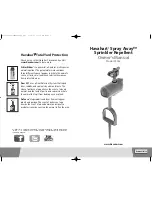
©
“WATEX” Ltd., Reg. Nr. 40003712811, Ganibu dambis 27 k-5, Riga, LV-1005; Contact information: tel. +371 67381989, e-mail:
[email protected], www.watex.eu
11
1.
Pull out the red clamp and
remove the brine elbow from its
port.
2.
Pull the pipe through the nut
3.
Insert the cylindrical insert at the
end of the tube, then the two
rings in turn.
4.
Insert the end of the pipe into the
brine elbow completely and
tighten by hand.
5.
Insert the brine elbow in its porte
and put in place the red clamp.
Note: The brine elbow has a
sealing ring that can be rotated in
the direction you want. The
turning angle is 270 degrees.
6.
Pull the other end of the tube
through the hole in the side of
the reagent tank and connect in
the same way as in points 2, 3
and 4. When the equipment is
connected to the water supply,
sewer, and the brine tank, add
salt tablets (NaCl) to the reagent tank and 15 liters of water for the first start up.
3.5. Connecting to electricity
The control valve is supplied with an electrical transformer for 220 V. The power supply to the
equipment must be provided at all times. The transformer is only intended for use in dry areas.
Note:
All electrical connections must be made in accordance with local regulations. Provide
uninterrupted power supply within 2 meters of the water filter.
There is a rectangular socket at the end of the transformer cable that must be connected to the
electronic plate on the control valve. To do this, do the following:
1. Remove the front plastic cover on the control unit.
2. At the top side on of the control valve, release the middle mounting tab that holds the system
board frame to the control valve.
3. The plastic wall of the control valve has an opening on the right side through which the end of the
transformer cable must be routed.
4. Connect the end of the cable to the contact port on the bottom right of the motherboard called
“power”.
5. The rest of the cable section must be routed along the side of the motherboard frame behind the
clamps provided.
6. Slide the control valve board frame back to the mounting tab and secure it in place.
7. Put back in place the plastic front cover.


































